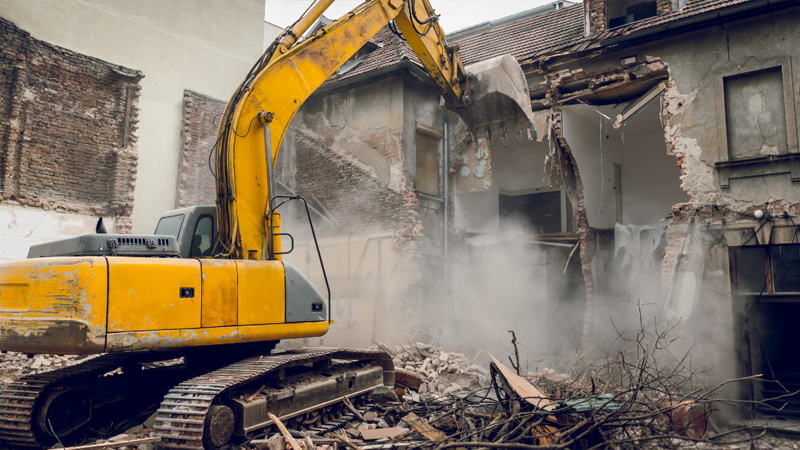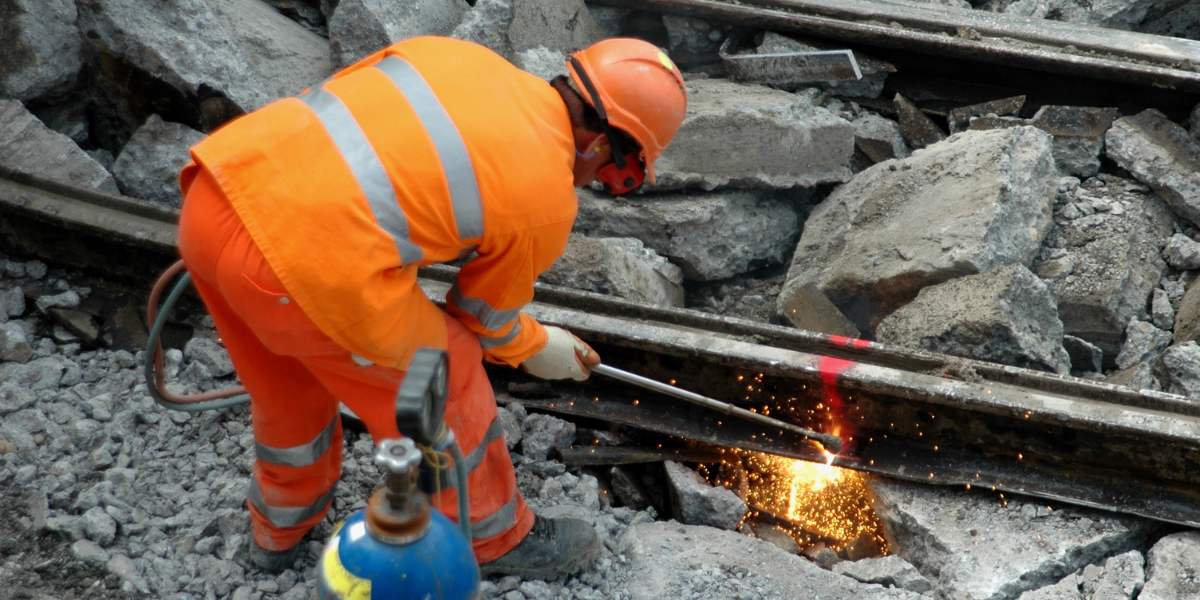What is Concrete Demolition? Methods, Costs, and Pro Tips

What is concrete demolition, and why does it matter?
Concrete demolition is the process of dismantling concrete structures that are damaged, outdated, or simply in the way.
When deep cracks, frost heave, or widespread damage strike, quick fixes won’t cut it—complete demolition is often the smartest move, especially for major commercial buildings or renovations.
From powerful drum cutter attachments to advanced demolition techniques, there’s a lot that goes into safely and efficiently demolishing concrete.
In this blog, we’ll break down concrete demolition methods, explain the costs, provide expert tips to guide your next project—and show you how RockZone Americas can make it all happen.
Key Takeaways
- Successful concrete demolition demands the right expertise and tools to ensure safety and efficiency, no matter the project's scale.
- Bringing in professionals minimizes risks, saves time, and keeps costs under control, especially for complex jobs.
- RockZone Americas provides top-tier equipment and expert services to make your demolition projects seamless and hassle-free.
Why Concrete Demolition is Necessary
Concrete structures are durable, but over time, damage becomes inevitable. From widespread cracks to foundational issues, deciding whether to repair or demolish concrete depends on the severity of the problem.
When to demolish concrete
Structural damage: Damage like deep cracks and frost heave weakens concrete slabs beyond repair. Large trucks and heavy use can further compromise the structure. This makes concrete removal the only solution.
Foundational issues: If the subgrade under a slab wasn’t properly compacted or erosion from water causes the slab to sink, simply patching it up won’t fix it. Uneven surfaces can create safety risks for surrounding structures.
Aging and deterioration: Even well-maintained reinforced concrete deteriorates. Rusting steel reinforcing and natural wear weaken the structure, which makes demolition necessary, especially in projects like commercial buildings or bridge decks.
6 Common Concrete Demolition Methods
Demolishing concrete isn’t a one-size-fits-all process. The concrete demolition method you choose depends on the project’s scale, the type of concrete structure, and the surrounding environment.
Here’s a look at the most commonly used methods and how they apply to different projects.
1. Manual methods
Manual demolition uses hand tools like sledgehammers, bolt cutters, pry bars, and smaller pneumatic and hydraulic breakers to break apart concrete slabs or sections.
While labor-intensive, this method allows for greater control and precision, especially in confined areas where larger machinery can't fit.
Best for:
- Small projects like demolishing a concrete patio or removing concrete slabs
- DIY concrete removal for home renovations
2. Mechanical methods
Mechanical methods utilize heavy machinery such as hydraulic breakers, boom-mounted pneumatic hammers, and skid steer loaders. These machines are capable of quickly breaking up larger, thicker concrete slabs or heavily reinforced concrete.
While efficient, mechanical methods require safety measures to handle flying debris and noise.
Best for:
- Large-scale projects like breaking up bridge decks or concrete driveway removal
- Commercial demolitions involving heavily reinforced concrete
3. Pressure bursting
Pressure bursting involves using hydraulic pressure or expansive slurry to split concrete structures in a controlled manner.
Mechanical bursting uses lateral hydraulic pressure provided by machines, while chemical bursting involves inserting slurry into drilled holes to create cracks. This method is effective for breaking down concrete without excessive dust or noise.
Best for:
- Sensitive projects like demolishing prestressed concrete structures
- Work in confined spaces or near other structures where minimal dust and noise are required
4. Ball and crane
The ball and crane method employs a large wrecking ball attached to a crane, which is swung or dropped to demolish concrete.
This is one of the oldest demolition techniques, known for quickly taking down large concrete structures. However, it produces significant dust, debris, and noise, requiring a lot of space to operate safely.
Best for:
- Large-scale demolitions, like tearing down old commercial buildings
- Projects requiring fast removal of large volumes of concrete
5. Explosives
Explosive demolition uses controlled blasts to break apart concrete structures. Boreholes are drilled into the concrete, and explosives are strategically placed to create a controlled manner of collapse.
While highly efficient for demolishing large reinforced concrete structures, this method requires strict safety measures due to the vibrations and air blasts.
Best for:
- Large structures like commercial buildings or bridges
- Projects where large volumes of concrete need to be demolished quickly
6. Water jetting technique (Hydro demolition)
Hydro demolition uses high-pressure water jets to break down concrete without damaging the underlying reinforcing steel.
This method is precise and minimizes dust and debris. It is ideal for areas where other demolition techniques might be too invasive or damaging.
Best for:
- Precision projects like removing portions of prestressed concrete structures
- Situations where preserving steel reinforcement or avoiding dust and vibrations is critical
What Influences Concrete Demolition Costs?
Planning a concrete demolition project? Understanding the key factors driving costs can help you budget effectively. Here's what you need to know.
Labor costs
Hiring demolition specialists ensures precision and safety, but it comes with a higher price tag than DIY concrete removal. Professionals bring expertise that minimizes risks and maximizes efficiency, which often saves time and money in the long run.
Disposal costs
Disposal costs can add up quickly, especially for larger demolition projects involving significant amounts of concrete debris. Recycling the material is a smart way to cut costs while keeping the process eco-friendly.
Heavily reinforced concrete or projects in urban areas might require more specialized disposal methods, which can increase overall expenses.
Square foot costs by method
The cost per square foot largely depends on the concrete demolition method used.
For example, pressure bursting offers precision and minimal disruption but may be pricier upfront. Meanwhile, mechanical demolition with hydraulic breakers might be more affordable for larger areas, though it may involve higher cleanup costs.
Additional costs for reinforced concrete and tight spaces
Demolishing reinforced concrete—with its tough steel reinforcement—requires specialized tools, increasing both labor and disposal costs.
Projects near surrounding structures or in tight spaces demand extra care, often necessitating more precise methods like pressure bursting, which can drive up expenses further.
Must-Know Safety Tips for Concrete Demolition
 \
\
Safety is non-negotiable in any concrete demolition project. From removing a concrete slab to taking down an entire structure, following key safety measures is vital for a smooth, risk-free operation. Here’s how to keep your site safe and efficient.
Top safety measures for a risk-free job
Proper planning, regular training, and vigilance are critical to keeping everyone safe on the demolition site. With hazards like flying debris and structural collapses, a strong safety protocol is essential.
Daily safety meetings: Regular safety meetings are crucial. They brief your crew on specific hazards for the day, such as heavy concrete pieces or dealing with loose dirt. These meetings keep everyone focused and prepared for the day’s tasks.
Protective gear: The right gear is a must. Steel-toed boots, safety goggles, ear protection, and gloves are necessary for protecting against flying debris, loud machinery like hydraulic breakers, and falling concrete elements. Every worker needs to be properly outfitted for their safety.
Clear work zones: Before demolition begins, clear the site of any unnecessary personnel. Only trained workers should handle heavy equipment like pneumatic and hydraulic breakers and power tools. This ensures fewer accidents and safer operations.
Why pros make all the difference
While DIY concrete removal may work for small jobs, larger demolition projects demand experienced contractors. Professionals ensure safety, precision, and proper execution.
Reducing risks: Hiring demolition specialists means working with experts who know the right demolition techniques for the job, like using pressure bursting near sensitive areas or minimizing ground movement in unstable conditions.
Safe equipment handling: From managing heavy machinery like ball and crane setups to handling structural collapse risks, professionals know how to work safely and efficiently. They can prevent accidents that could otherwise cost time, money, or worse.
Expert control: Demolition is unpredictable, especially when working with damaged concrete. Experienced contractors manage the site so that everything stays controlled and compliant with local regulations, even in tight spaces or near surrounding structures.
RockZone Americas: The Trusted Experts in Concrete Demolition
Concrete demolition comes with its own set of challenges—concrete slab removal costs, dealing with reinforced concrete, and ensuring safety in every step of the process. RockZone Americas understands these pain points and provides the solutions you need.
Our experienced team is equipped with advanced tools and cutting-edge technology. From small residential concrete removal to large-scale building demolition, we ensure every project is handled with precision, efficiency, and safety.
At RockZone, we don't just demolish—we excel. Our industry-leading equipment, including the powerful Rockwheel drum cutters, is designed to reduce disruptions, keep disposal costs low, and deliver results that stand out.
When you partner with RockZone Americas, you're guaranteed a smooth, safe, and highly efficient demolition experience. Ready to start your next project? Call us today.
Summary
Concrete demolition is no simple task. It requires expertise, precision, and the right tools, especially for large-scale or heavily damaged concrete structures.
With the variety of demolition methods and challenges like concrete slab removal costs or managing debris from unreinforced concrete, leaving this work to professionals ensures a safe and profitable job. When done right, the process minimizes risks and also keeps everything on track and within budget.
RockZone Americas excels at delivering top-tier concrete demolition projects. Our advanced equipment, combined with a team of skilled experts, guarantees efficiency and safety at every step. From removing concrete patios to complex building demolition, we’ve got the experience to handle it all with precision.
Frequently Asked Questions
What is the method of concrete demolition?
The method of concrete demolition depends on the project’s scale and type of concrete structure. Each method is selected to efficiently and safely remove concrete while minimizing risks and costs.
Common concrete demolition techniques include manual tools like pry bars and sledgehammers, mechanical equipment such as hydraulic breakers, and more advanced options like pressure bursting or explosives.
What does demo concrete mean?
"Demo concrete" refers to the process of breaking down and removing concrete structures that are no longer functional or safe. This can involve demolishing anything from a small concrete patio to large sections of concrete construction using specialized demolition methods.
The goal is to remove concrete to make way for new concrete or redevelopment projects.
What is demolished concrete called?
Demolished concrete is typically referred to as concrete debris or concrete pieces. After the demolition process, these pieces are often sorted for recycling or disposal.
Recycled concrete elements can be repurposed for use in new construction projects, reducing disposal costs and minimizing environmental impact.
